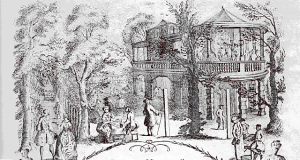Town gardens

- Town Gardens
- [click on the picture to enlarge it]
Though the eighteenth century was the age of landscape gardening in the country estates of the nobility and gentry, the parks and gardens accessible to the town-dwellers remained fairly modest in scale and uninnovative in their plantations. The still easy access to the neighbouring countryside explains the relative lack of importance of urban gardens. They however gradually developed, following the pace of urbanisation, and by 1770 some thirty towns in Britain had gardens.
The squares designed in the new developments, in Bath and Edinburgh as well as in London, though they were originally planned as green spaces for recreation, such as Queen’s Square in Bath (1736), or Grosvenor Square in London (1730), were normally surrounded by railings and open only to residents.
Walks were opened in the major towns and in the spas. They were most often gravelled alleys planted with several parallel rows of trees. The world of fashion would meet there on summer days. Pall Mall in London attracted the members of high society, duly attended by their footmen. The Pantiles, in Tunbridge Wells,were visited by those who came to take the waters. Bath had planted walks on both sides of the river Avon. York offered a long planted alley on the banks of the Ouse. Even smaller towns such as Leicester and Preston opened their public walks.
Londoners and the inhabitants of a few provincial towns could also frequent pleasure gardens such as Ranelagh and Vauxhall in London and Spring Gardens in Bath, with an entrance fee. There they could not only eat and drink or dance, but also listen to music, attend shows and watch fireworks.
London gardens: London was undoubtedly best provided with gardens of all types. The inhabitants of the West End had the privilege of frequenting some royal parks open to the public, such as the huge Hyde Park, but also Green Park and St James’s Park. The inhabitants of the old City, to the East, were less fortunate and had to be content with a few small green places such as Moorfields, where Wesley and Whitefield preached. The South bank of the Thames, on the other hand, still offered vast empty spaces such as St George’s Fields, which, though left wild, were used for recreation by the labouring classes.

